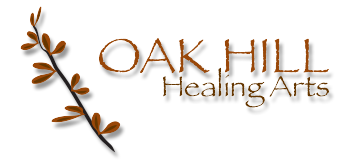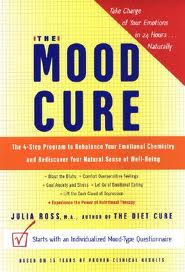
one person at a time

The other excellent read for anyone who has experienced depression or anxiety is “The Mood Cure: The 4-Step Program to Take Charge of Your Emotions – Today,” by Julia Ross, M.A. This book is a powerful discourse in nutrition and brain chemistry. Yes, all the biochemistry stuff that’s so hard to grok – but she breaks it down very simply. First, she helps to identify, through a behavioral questionnaire, which of the neurotransmitters is in short supply: serotonin, catecholamines, GABA, or endorphins. Then she explores which missing nutrients or depleting factors are responsible for their short supply.
 Although all of these neurotransmitters are important, I’m going to focus here exclusively on serotonin, because it is probably the most commonly deficient and the most commonly prescribed for. This neurotransmitter is found largely in the GI tract. It is synthesized from tryptophan, and it is the predominant regulator of mood, appetite and sleep. Aside from the mood symptoms I cited at the beginning of this article, physical indicators of serotonin deficiency may include 1) gut problems, 2) heart problems, 3) sleep problems, 4) fibromyalgia and other chronic pain, and 5) cravings, especially in the evenings, for carbs, alcohol, and certain drugs. (Are you getting the picture of why Ross thinks its deficiency is epidemic?)
Although all of these neurotransmitters are important, I’m going to focus here exclusively on serotonin, because it is probably the most commonly deficient and the most commonly prescribed for. This neurotransmitter is found largely in the GI tract. It is synthesized from tryptophan, and it is the predominant regulator of mood, appetite and sleep. Aside from the mood symptoms I cited at the beginning of this article, physical indicators of serotonin deficiency may include 1) gut problems, 2) heart problems, 3) sleep problems, 4) fibromyalgia and other chronic pain, and 5) cravings, especially in the evenings, for carbs, alcohol, and certain drugs. (Are you getting the picture of why Ross thinks its deficiency is epidemic?)
So, first of all – where has all your serotonin gone? Ross cites 5 not-too-surprising causes. Serotonin is depleted:
Okay, you must read her book to get the whole story on all this, but a quick glance at this list should tell you why we have epidemic levels of depression, given what’s now known as the Standard American Diet – which is also appropriately acronymmed “SAD.”
So. What does Ross recommend to correct serotonin deficiency – aside from the predictable less stress, more exercise and more sunlight or full-spectrum light? Well, she gives lots of information about three over-the-counter supplements and one well-known herb. The supplements she recommends are the unmemorable sci-fi names 5-HTP and SAM-e, also the oldie-but-goodie, tryptophan, and the herb is St-John’s-wort.
The relatively new 5-HTP (5-hydroxy-tryptophan) is an inexpensive pill made from an African bean and it is widely available in health food stores. Give the body enough tryptophan and it makes its own 5-HTP, which it then converts to serotonin, and the brain gets happy. The benefits of 5-HTP have been widely studied and published, and compared favorably in clinical trials alongside Prozac and other antidepressant drugs.
A good chunk of the serotonin-starved population respond well to 5-HTP, but a small percentage of them do not. It doesn’t seem to harm anyone, aside from making them queasy – it just doesn’t relieve their symptoms. For these individuals, another amino acid is available with a longer history: tryptophan, the precursor to 5-HTP.
Remember tryptophan, folks? It was the go-to happy pill in the late 70s and early 80s. Everyone was taking it and magazine articles extolled its helpfulness. Pharmaceutical companies couldn’t get a foothold in the market with antidepressant drugs, in fact, because tryptophan was easy, cheap, harmless, and worked for nearly everybody and worked quickly. Trouble came to paradise one day in 1989, however, when a Japanese amino acid manufacturer sent a bad batch of tryptophan to the US. This batch killed over 40 people, made many people ill, and got a LOT of press. Despite the facts that that particular manufacturer went out of business and that all other manufacturers upped their (already unblemished) quality control standards, tryptophan became persona non grata in American medicine cabinets. This was good news only for the pharmaceutical companies, who now gained entry to a waiting market – and the last two decades have been VERY good for them.
In Europe, the popularity of tryptophan never waned, and in fact in recent years, thanks to scientific conferences and research in Europe, much has been published on the successful use of tryptophan to treat “resistant” depression.
St-John’s-Wort is an herb that has also gotten a tarnished reputation in America, although for a different reason. This lovely herb has been used as a safe and reliable antidepressant for 30 years, and in parts of Europe it still outsells pharmaceuticals – why is this not true not here? American marketing practices. It happens sometimes that once an herb gets a little recognition in this country, manufacturers jump on the bandwagon and start making it available to discount pharmacies at very low prices – which typically means they are using low-quality herb, the wrong parts of the plant, and insufficient strength. (The US doesn’t have the truth-in-labeling restrictions that are more common in Europe.) When consumers try the Walmart version of the herb, with no other experience of it, they say “It did nothing to help me.” Poor old St-John’s-Wort was one such casualty. Ross cites quite a bit of current research to restore the reputation of this extremely useful herb – taken in proper dosage, and from a reliable manufacturer.
All authors Ross, Breggin, and Cohen recommend working with a qualified practitioner to make the journey out of depression and anxiety. Another reason cited for failure in the use of supplements is that consumers will often self-prescribe – since most of these are available over-the-counter – and without feedback about proper dosages, lab work, duration of treatment, etc., they determine that they aren’t seeing results. All authors acknowledge that it takes time – something that, sadly, most MDs are no longer allowed. And nutritional rehab takes dedication on the part of the patient – something that requires willingness. But they all do agree that it is possible for everyone to “lift the dark cloud” without resorting to chemicals.